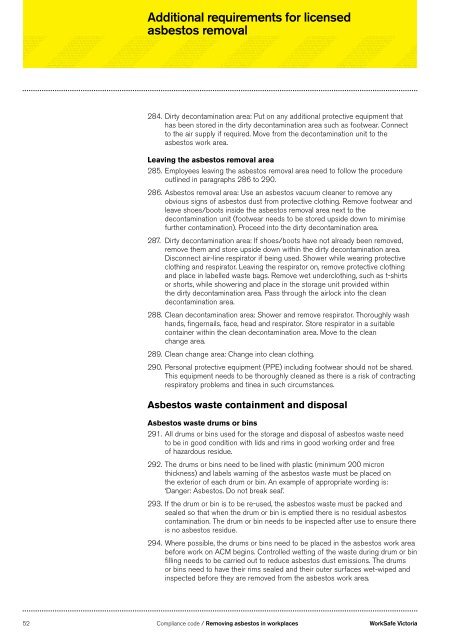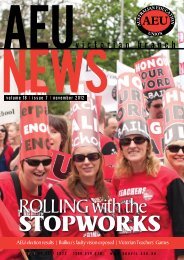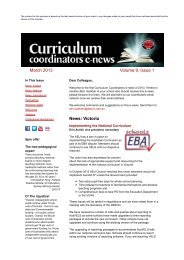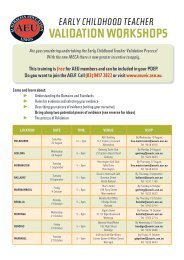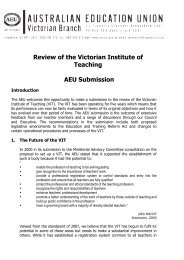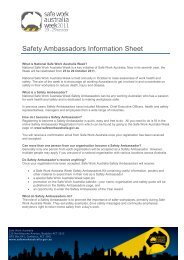Removing asbestos in workplaces - Compliance ... - WorkSafe Victoria
Removing asbestos in workplaces - Compliance ... - WorkSafe Victoria
Removing asbestos in workplaces - Compliance ... - WorkSafe Victoria
You also want an ePaper? Increase the reach of your titles
YUMPU automatically turns print PDFs into web optimized ePapers that Google loves.
Additional requirements for licensed<strong>asbestos</strong> removal284. Dirty decontam<strong>in</strong>ation area: Put on any additional protective equipment thathas been stored <strong>in</strong> the dirty decontam<strong>in</strong>ation area such as footwear. Connectto the air supply if required. Move from the decontam<strong>in</strong>ation unit to the<strong>asbestos</strong> work area.Leav<strong>in</strong>g the <strong>asbestos</strong> removal area285. Employees leav<strong>in</strong>g the <strong>asbestos</strong> removal area need to follow the procedureoutl<strong>in</strong>ed <strong>in</strong> paragraphs 286 to 290.286. Asbestos removal area: Use an <strong>asbestos</strong> vacuum cleaner to remove anyobvious signs of <strong>asbestos</strong> dust from protective cloth<strong>in</strong>g. Remove footwear andleave shoes/boots <strong>in</strong>side the <strong>asbestos</strong> removal area next to thedecontam<strong>in</strong>ation unit (footwear needs to be stored upside down to m<strong>in</strong>imisefurther contam<strong>in</strong>ation). Proceed <strong>in</strong>to the dirty decontam<strong>in</strong>ation area.287. Dirty decontam<strong>in</strong>ation area: If shoes/boots have not already been removed,remove them and store upside down with<strong>in</strong> the dirty decontam<strong>in</strong>ation area.Disconnect air-l<strong>in</strong>e respirator if be<strong>in</strong>g used. Shower while wear<strong>in</strong>g protectivecloth<strong>in</strong>g and respirator. Leav<strong>in</strong>g the respirator on, remove protective cloth<strong>in</strong>gand place <strong>in</strong> labelled waste bags. Remove wet undercloth<strong>in</strong>g, such as t-shirtsor shorts, while shower<strong>in</strong>g and place <strong>in</strong> the storage unit provided with<strong>in</strong>the dirty decontam<strong>in</strong>ation area. Pass through the airlock <strong>in</strong>to the cleandecontam<strong>in</strong>ation area.288. Clean decontam<strong>in</strong>ation area: Shower and remove respirator. Thoroughly washhands, f<strong>in</strong>gernails, face, head and respirator. Store respirator <strong>in</strong> a suitableconta<strong>in</strong>er with<strong>in</strong> the clean decontam<strong>in</strong>ation area. Move to the cleanchange area.289. Clean change area: Change <strong>in</strong>to clean cloth<strong>in</strong>g.290. Personal protective equipment (PPE) <strong>in</strong>clud<strong>in</strong>g footwear should not be shared.This equipment needs to be thoroughly cleaned as there is a risk of contract<strong>in</strong>grespiratory problems and t<strong>in</strong>ea <strong>in</strong> such circumstances.Asbestos waste conta<strong>in</strong>ment and disposalAsbestos waste drums or b<strong>in</strong>s291. All drums or b<strong>in</strong>s used for the storage and disposal of <strong>asbestos</strong> waste needto be <strong>in</strong> good condition with lids and rims <strong>in</strong> good work<strong>in</strong>g order and freeof hazardous residue.292. The drums or b<strong>in</strong>s need to be l<strong>in</strong>ed with plastic (m<strong>in</strong>imum 200 micronthickness) and labels warn<strong>in</strong>g of the <strong>asbestos</strong> waste must be placed onthe exterior of each drum or b<strong>in</strong>. An example of appropriate word<strong>in</strong>g is:‘Danger: Asbestos. Do not break seal’.293. If the drum or b<strong>in</strong> is to be re-used, the <strong>asbestos</strong> waste must be packed andsealed so that when the drum or b<strong>in</strong> is emptied there is no residual <strong>asbestos</strong>contam<strong>in</strong>ation. The drum or b<strong>in</strong> needs to be <strong>in</strong>spected after use to ensure thereis no <strong>asbestos</strong> residue.294. Where possible, the drums or b<strong>in</strong>s need to be placed <strong>in</strong> the <strong>asbestos</strong> work areabefore work on ACM beg<strong>in</strong>s. Controlled wett<strong>in</strong>g of the waste dur<strong>in</strong>g drum or b<strong>in</strong>fill<strong>in</strong>g needs to be carried out to reduce <strong>asbestos</strong> dust emissions. The drumsor b<strong>in</strong>s need to have their rims sealed and their outer surfaces wet-wiped and<strong>in</strong>spected before they are removed from the <strong>asbestos</strong> work area.52 <strong>Compliance</strong> code / <strong>Remov<strong>in</strong>g</strong> <strong>asbestos</strong> <strong>in</strong> <strong>workplaces</strong> <strong>WorkSafe</strong> <strong>Victoria</strong>


